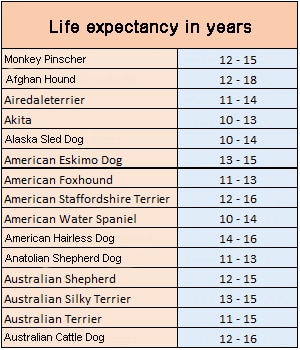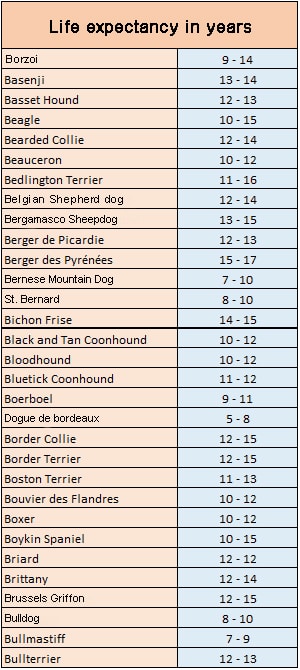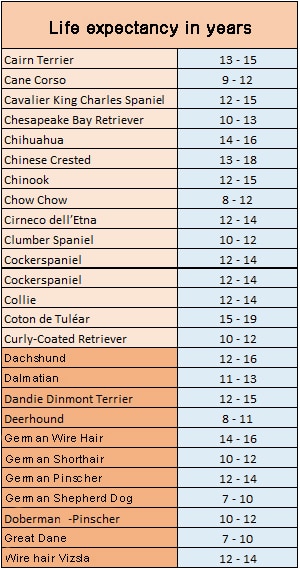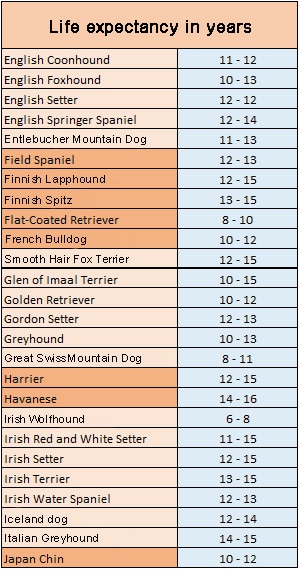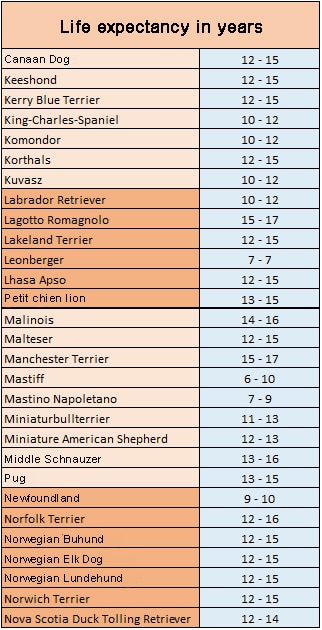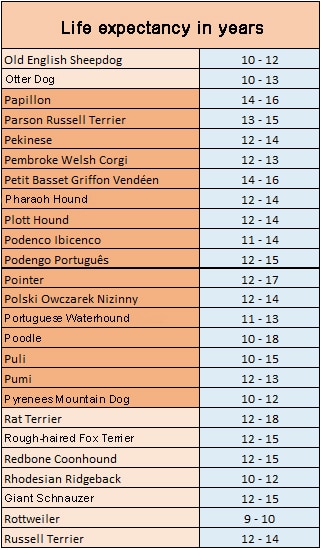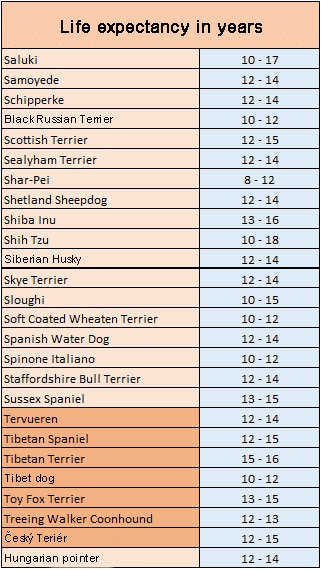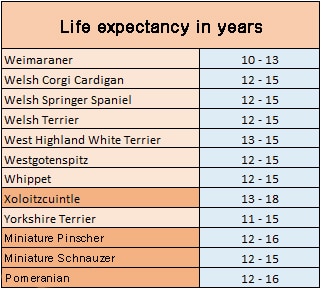5 facts about: How old do dogs get?
- Veterinarian Mag.med.vet. Emin Jasarevic
- Updated: 2023-04-13
You want to know how old dogs get? The answer to these questions and a few exciting facts on this topic I have written for you in this guide. I would be surprised if you already know all the facts! So have fun reading.
Also, for this article I have taken Advice from veterinarian Mag.med.vet. Emin Jasarevic obtained. Note: This article is written for the german country. So be curious.

Dog life expectancy
How old do dogs get?
Actually, it is impossible to give a blanket answer to this question. Because life expectancy depends on various factors, such as:
- Breed, genetics, breed size
- Living conditions
- Nutrition
- Care
- Environment
- Activity
When calculating the average life expectancy of dogs, the breed is taken as a starting point. The breed is divided into small, medium and large dog breeds.
- Small breeds: up to 15 kg body weight
- Medium breeds: 15 to 45 kg body weight
- Large breeds: more than 45 kg body weight

- Small breeds: 10 to 15 years.
Some can even live up to 18 years. - Medium breeds: 10 to 13 years.
Some of the breeds can also live longer. - Large breeds: 8 to 12 years
- Giant breeds: 8 to 10 years
Average life expectancy of individual breeds
According to the American Kennel Club (governing body of purebred dog breeders USA), the Dogue de Bordeaux with an average of 5 to 8 years the shortest life expectancy.
With an average of 15 to 19 years, the Coton de Tuléar (cotton dog) has the highest life expectancy.
Do mixed breeds live longer?

In general, mixed breeds really live longer.
Breeders of purebred dogs take the size or special breed characteristics of the dogs as an approach when breeding.
According to Dr. Kraus, it would be possible to increase life expectancy if life expectancy were considered instead of these breed characteristics.
For example, the researcher recommends, "If you want to live with your dog as long as possible, you have the best chance if you choose a mixed breed, and a rather small one at that."
"Dog Years" vs. "Human Years"
The old rule that 1 dog year equals 7 human years is long outdated.
Meanwhile, the size or weight of the dog is also included in the conversion. Please note that the following table are only estimates:

How can I ensure a long & fulfilling life for my dog?

The Guinness Book of Records lists "Bluey" as the oldest dog. Bluey was an Australian hunting dog.
He lived in Australia / Rochester as a working dog among cattle and sheep. He was 29 years and 5 months old. He was purchased as a puppy in 1910 and euthanized on November 14, 1939.
Of course, the life expectancy of a dog depends not only on its breed or weight.
The design of his life is also crucial. The healthier and more active he lives, the higher the life expectancy can be.
Just as with humans
- Balanced diet
- Much movement
- Physical care and spiritual care
- Regular preventive medical visits
Most common causes of early death
Of course, it would be wonderful if our furry noses could reach the average life expectancy or not leave us at all.
Unfortunately, there are illnesses or circumstances when our loved ones can't cope and have to leave us unexpectedly. The most common causes are:
1. cancer
Cancer is a common cause of death in large dog breeds. Why the cancer rate is higher in larger dogs compared to smaller breeds has not yet been fully elucidated.
However, scientists believe that it is due to the faster growth rate in puppies. Thus, the cells are more prone to develop abnormally, which increases the risk of cancer.
The symptoms of cancer are:
- Node
- Poorly healing or non-healing wounds
- Weight loss
- Enlarged lymph nodes
- Bloated belly
- Abnormal bleeding
- Weakness
- Swellings
2. injuries
The spectrum of injuries that can be fatal for dogs is diverse. It can be a car accident or the aftermath of a bite from a conspecific.
The incidence of these deaths is higher in puppies and small dog breeds. Working dogs are also more likely to be affected.
You can take easy steps to ensure your charge doesn't suffer from preventable injuries:
- Never walk without a leash.
- Always keep a caring eye on your best friend - even when you're at home.
- Eliminate the sources of danger in your apartment. It should be dog-proof (decorative objects, balcony, stairs, electrical outlet, cables lying around, poisonous plants, etc.).
3. hereditary diseases
Hereditary diseases are not always detectable or predictable. Here, it is important that you purchase your dog from a breeder who is responsible with their breeding methods.
So you can reduce the risk to the minimum. There are many breeders who also take life expectancy and health to heart in their breeding. They have their breeding bitches and males medically examined for hereditary diseases before they are used.
4. infections
Since preventive vaccinations have been available, many dangerous infectious diseases are not as big a risk as they used to be. Nevertheless, every year numerous dogs become ill or even fatalities due to various infectious diseases.
You can reduce this risk: Have your pet vaccinated regularly and take him to the vet for regular checkups.
5. overweight
As a good example of this is the USA. About 34 % of dogs in the U.S. are overweight or obese. That's a valid reason to be concerned.
Because researchers have proven that the life expectancy of dogs with overweight or obesity is on average two years shorter compared to dogs with a normal body weight.
Excess weight puts a strain on your dog's musculoskeletal system - the consequences can be osteoarthritis and disc disease.
In addition, the risk of developing diabetes or pancreatitis is very high. Cardiovascular disorders and respiratory problems are also unwelcome guests.
That's why you should give your dog a balanced diet and make sure he gets plenty of exercise. Please do not forget that dogs are active creatures since their origin.
They need this activity not only for their physical health, but also for their mental health and balance.
Frequently Asked Questions
The average lifespan of a dog depends on the breed and its living conditions. It is true that smaller breeds live longer than larger breeds. Small breeds live about 13 years and large breeds about 10.
The most common cause of death in dogs is cancer, followed by injuries and accidents, hereditary diseases, infections and lastly obesity.
In order for your dog to live as long and healthy a life as possible, a balanced diet, plenty of exercise, physical care, mental care and regular preventive medical visits are necessary.
The Guinness Book of Records lists "Bluey" as the oldest dog. Bluey was an Australian hunting dog. He lived in Australia / Rochester as a working dog between cattle and sheep. He became proud 29 years and 5 months old.
This conversion method has long been outdated. To make a rudimentary correct transfer of the dog age to the human age, you have to take into account several factors such as the breed. On the table in our article you can get more detailed information.
Conclusion
Of course, we all want our loved ones to be with us for life.
However, statistics are not enough for our dear friends to reach their average life expectancy.
The mere fact that the life expectancy is long is no guarantee that your faithful companion will also have a full life.
The goal is not just to live long. The goal should be to make the way step by step balanced and happy.
The point is not just the quantity, but rather the quality of time spent together and for each other. This rule of thumb applies both to our dear furry noses and to life itself.
Then the expectation of extensive togetherness is also every moment where it should be:
Do not live in the future, but in the present - actively, fully together with us.
In this sense, our dear friends are truly skilled masters! From them we can really still learn a lot 😉

I am a veterinarian and writer on animal health topics. Animals are my passion, and it is my personal goal to create medically accurate articles and videos to educate pet owners as much as possible.
Share Now:
